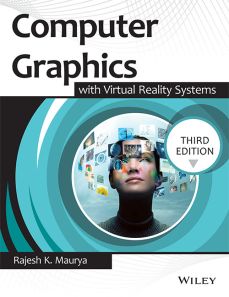Computer Graphics with Virtual Reality System, 3ed
ISBN: 9788126576333
648 pages
For more information write to us at: acadmktg@wiley.com

Description
Computer Graphics with Virtual Reality Systems is a comprehensive book for students of computer science, engineering and information technology. The book is a must-have for students, professionals and practitioners interested in understanding object design and visualization, transformation, modeling and animation of real world. Besides, the book is also useful for students of diploma courses and vocational courses at open universities, distance education universities in graphics and animation. Scholars and practitioners, studying computer graphics, image analysis and multimedia courses, can also find the book very helpful.
Contents
Preface v
1. Introduction to Computer Graphics and Display Systems
1.1 Introduction
1.2 Image and objects
1.3 Image representation
1.4 Basic graphics pipeline
1.5 Raster and vector-based graphics
1.6 Applications of computer graphics
1.7 Display devices
1.8 Cathode ray tubes
1.9 Flat panel display
1.10 3D display technology
1.11 Input technology
1.12 Hard-copy output devices
1.13 Coordinate system overview
1.14 Introduction to graphics libraries in C
2. Scan-Conversion of Graphics Output Primitives
2.1 Introduction
2.2 Scan-conversion of a point
2.3 Scan-conversion of lines
2.4 Scan-conversion of circle
2.5 Scan-conversion of ellipse
3. Curve Generation
3.1 Introduction
3.2 Curve continuity
3.3 Conic curves
3.4 Piecewise curve design
3.5 Parametric curve design
3.6 LeGrange interpolated curves
3.7 Spline curve representation
3.8 Non-uniform rational B-spline curves
3.9 Fractal curves
4. Area Filling and Solid Area Scan-Conversion
4.1 Introduction
4.2 Inside–outside test
4.3 Winding number method
4.4 Coherence
4.5 Polygon filling
4.6 Scan conversion of character
4.7 Aliasing
4.8 Anti-aliasing
4.9 Halftoning, thresholding, and dithering
5. Two-Dimensional Transformation
5.1 Introduction
5.2 Transformation matrix
5.3 Types of transformations in two-dimensional graphics
5.4 Combined transformation
5.5 Homogeneous coordinates
6. Two-Dimensional Viewing and Clipping
6.1 Introduction
6.2 Viewing transformation in two dimensions
6.3 Introduction to clipping
6.4 Two-dimensional clipping
6.5 Text clipping
7. Three-Dimensional Transformation, Viewing and Projection
7.1 Introduction
7.2 Objects in homogeneous coordinates
7.3 Three-dimensional transformations
7.4 World coordinates and viewing coordinates
7.5 Three-dimensional viewing transformations
7.6 Projection
7.7 Viewing and clipping in three dimensions
8 Surface Generation
8.1 Introduction
8.2 Bilinear surfaces
8.3 Ruled surfaces
8.4 Developable surfaces
8.5 Coons patch
8.6 Sweep surfaces
8.7 Surface of revolution
8.8 Quadric surfaces
8.9 Constructive solid geometry
8.10 Bezier surfaces
8.11 B-spline surfaces
8.12 Rational B-spline surfaces
8.13 Subdivision surfaces
9. Visible and Hidden Surfaces
9.1 Introduction
9.2 Coherence
9.3 Extents and bounding volumes
9.4 Back face culling
9.5 Painter’s algorithm
9.6 Z-buffer algorithm
9.7 Newell’s algorithm
9.8 Scan line rendering
9.9 Appel’s algorithm
9.10 Warnock’s area subdivision algorithm
9.11 Binary space partitioning trees
9.12 Floating horizon algorithm
9.13 Roberts algorithm
9.14 Haloed lines
10. Object-Rendering and Color Models
10.1 Introduction
10.2 Light modeling techniques
10.3 Illumination model
10.3.1 General illumination model
10.4 Shading
10.5 Transparency effect
10.6 Shadows
10.7 Texture and object representation
10.8 Ray tracing
10.9 Ray casting
10.10 Radiosity
10.11 Color models
11. Computer Animation
11.1 Introduction
11.2 Key frame animation
11.3 Construction of an animation sequence
11.4 Motion control methods
11.5 Procedural animation
11.6 Key frame animation vs. procedural animation
11.7 Introduction to morphing
11.8 Warping techniques
11.9 Three-dimensional morphing
12. Introduction to Virtual Reality
12.1 Introduction
12.2 Classical components and design of a VR system
12.3 Important factors in a virtual reality system
12.4 Types of virtual reality systems
12.5 Advantages of virtual reality
12.6 VR Input devices
12.7 Graphics display interfaces
12.8 Sound display and interface
12.9 Examples of input devices
12.10 Haptic feedback
12.11 Graphical rendering pipeline
12.12 Haptic rendering pipeline
12.13 OpenGL rendering pipeline
12.14 Applications of virtual reality
13. Object Modeling and Computer Architecture for Virtual Reality
13.1 Introduction
13.2 Modeling techniques in virtual reality
13.3 Model management
13.4 PC graphics architecture and accelerators
13.5 The SGI reality architecture
13.6 Scene graph-based systems
13.7 The Sun Blade™0 architecture
13.8 Sun Blade0 workstation graphics
13.9 Distributed VR environment
14. Virtual Reality and Augmented Reality Programming
14.1 Introduction
14.2 Programming through VRML
14.3 Extensible 3D (X3D)
14.4 VRML/X3D Browsers and Plugins
14.5 Java 3D: Programming the virtual world through Java
14.6 Introduction to OpenGL programming
14.7 Augmented reality
14.8 OpenCV for augmented reality
Summary
Review Questions
Multiple-Choice Questions
Appendix A. List of Abbreviations
Appendix B. Programming Exercises
Bibliography
Index

